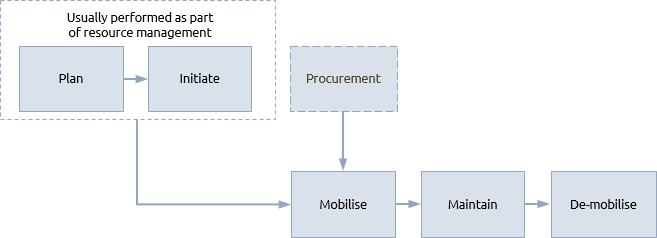General
Mobilisation makes sure that appropriate organisational and technical infrastructures are in place for acquiring and deploying resources. It also ensures that these are dismantled or redeployed when no longer required.
The goals of mobilisation are to ensure that:
- capital assets are operational and accessible;
- facilities are operational and accessible;
- delivery team members are competent and capable;
- all resources are redeployed, returned or disposed of, at the end of the work.
Mobilisation occurs at various points in the life cycle. The way mobilisation operates within the life cycle processes is covered by the corresponding activities in definition process and boundaries process.
During the identification process and definition process some mobilisation will be required to put in place teams, and possibly facilities, that can complete the work. Mobilisation of the full project infrastructure will occur once authorisation has been given (although some limited mobilisation may take place earlier to shorten the overall schedule). Mobilisation is also used to a lesser extent as each tranche or stage is started and finished.

On larger projects or programmes some mobilisation will be performed at the beginning of each stage or tranche. In a portfolio it is simply the decision to operate formal portfolio management that authorises the creation of a suitable infrastructure.
The mobilisation procedure can cover any of the following:
- the management team;
- premises;
- IT hardware, software tools and telecoms;
- plant and machinery;
- internal and external resources;
- governance procedures.
The initial management organisation is put in place to execute the identification and definition phases of a project or programme. The full organisation that will manage the delivery phase is designed during the definition process and, after approval of the full business case, the various posts are filled.
In many cases, the management teams will be located in existing premises. These management teams should be co-located whenever possible to improve communication and teamwork. Sometimes co-location isn’t possible, this may be because multiple companies are working in partnership or because work is managed in different countries. This will put additional pressure on the cohesion of the management team and IT infrastructure that facilitates virtual teams must help alleviate this.
Acquiring resource from internal sources often involves difficult negotiation. In a matrix organisation, for example, resources may retain their departmental home as well as having a role in a project, programme or portfolio. The P3 manager’s resource plans may conflict with business-as-usual demands when trying to allocate these resources. That is when good conflict management and influencing skills will come to the fore.
The temporary nature of projects and programmes means that mobilisation will always be followed by demobilisation once the work is complete. This is has an impact on widely differing aspects of the work:
-
where capital investment in plant and machinery is needed, decisions must be made whether to buy, with resale in mind, lease or rent;
-
when P3 teams are being built, their managers must always bear in mind that approaching demobilisation affects traditional team cycles such as Tuckman.
As the need to demobilise approaches, plans must be drawn up to dispose of assets, redeploy staff and, if necessary, reinstate premises to their previous condition.
Projects, programmes and portfolios
On some small projects very little will be needed in the form of form mobilisation. Facilities are all in place and resources don’t need to physically move. What needs to be done is more about teamwork than mobilisation.
However, models for team work are normally based on semi-permanent business-as-usual teams rather than the transient teams found in projects and programmes. Even small projects must consider the demobilisation of the team.
When mobilising programmes and large complex projects, the management team must consider the needs of the component work packages or projects. While the management team and its infrastructure will be in place for the duration of the work, there will be components that need to be mobilised and demobilised during the course of the life cycle.
In these situations the management team must consider the impact of the overall schedule on the infrastructure requirements. Some options for the way the way the work is structured may have a significant impact on the infrastructure costs. For example, the ability to share the costs of mobilisation across multiple projects must be weighed against the impact on benefits and the business case.
A portfolio organisation has is more permanent than projects and programmes, although a structured portfolio may go through multiple planning cycles and be reshaped according to the needs of a revised strategic plan. Portfolio mobilisation is typically a one-off project that sets up the infrastructure required to co-ordinate projects and programmes through multiple cycles.
A dedicated portfolio infrastructure forms the basis for an organisation to improve its capability maturity. It may be set up to include permanent organisational structures, such as a project management office (PMO) to provide support and governance. There could also be communities of practice to support the continual improvement of individual competence, or professional development programmes to encourage professionalism.
The mobilisation of a portfolio requires support and commitment at the host-organisation’s board-level to ensure that it is thorough and resilient. Only then will the portfolio infrastructure be embedded in the organisation as the preferred way of delivering projects and programmes.





